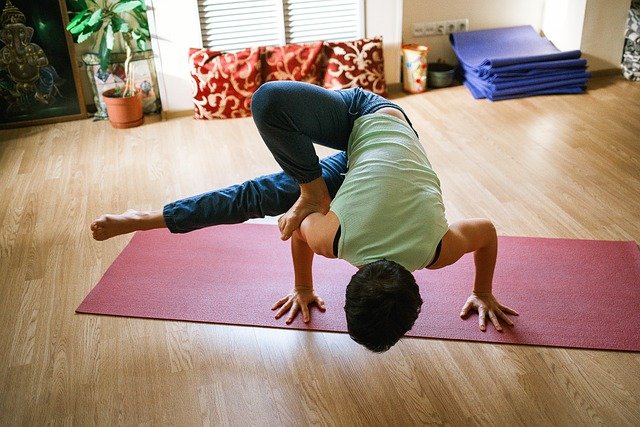Essential Guide to Yoga Mats for Home Practice
Yoga mats serve as the foundation for safe and effective home practice, providing the necessary grip, cushioning, and defined space needed for various poses and exercises. Whether you're a beginner starting your yoga journey or an experienced practitioner deepening your home routine, understanding the different aspects of yoga mats can significantly enhance your practice experience and help you make informed decisions about this essential equipment.

Key Functions of Home Yoga Mats Explained
Home yoga mats serve multiple essential functions that go beyond simply marking your practice space. The primary function involves providing a non-slip surface that prevents sliding during poses, which becomes particularly important during flowing sequences or challenging balance poses. The textured surface of quality yoga mats creates friction between your hands, feet, and the floor, allowing you to hold poses safely without worrying about slipping.
Another crucial function is cushioning and joint protection. Yoga mats provide a buffer between your body and hard flooring surfaces, reducing pressure on knees, wrists, and other sensitive areas during floor-based poses. This protective layer becomes especially important for practitioners who spend extended time in kneeling positions or perform poses that require direct contact with the ground.
Yoga mats also create a designated practice space within your home environment. This psychological boundary helps establish focus and routine, making it easier to transition into a mindful practice state even in familiar surroundings.
Different Types of Yoga Mats for Home Practice
Several distinct types of yoga mats cater to different practice styles and personal preferences. PVC mats represent the most common option, offering excellent grip and durability at accessible price points. These synthetic mats typically provide reliable traction and easy maintenance, making them suitable for various yoga styles and frequent use.
Natural rubber mats appeal to environmentally conscious practitioners, offering superior grip and cushioning while maintaining eco-friendly properties. These mats often provide excellent traction even during sweaty practices, though they may require more careful maintenance and can be heavier than synthetic alternatives.
Cork yoga mats combine natural materials with antimicrobial properties, creating surfaces that become grippier as they absorb moisture. These mats work particularly well for practitioners who prefer natural materials and need reliable grip during more intense sessions.
TPE (Thermoplastic Elastomer) mats offer a middle ground between synthetic and natural options, providing good grip and cushioning while being recyclable and free from harmful chemicals commonly found in PVC products.
Features That Make Yoga Mats Practical for Daily Exercise
Several key features contribute to a yoga mat’s practicality for regular home use. Thickness plays a crucial role in comfort and portability, with standard mats ranging from 3mm to 6mm. Thicker mats provide more cushioning for sensitive joints but can create instability during standing balance poses, while thinner mats offer better ground connection but less joint protection.
Surface texture significantly impacts grip and comfort. Mats with subtle texturing provide better traction without being abrasive against skin, while overly smooth surfaces can become slippery during practice. The ideal texture allows secure hand and foot placement without causing discomfort during extended contact.
Size considerations affect both practice comfort and storage convenience. Standard mats measure approximately 68 inches long and 24 inches wide, though longer options accommodate taller practitioners. Width variations can provide extra space for arm movements or lateral poses.
Easy cleaning and maintenance features make daily use more practical. Mats that can be easily wiped down or machine washed encourage regular cleaning, promoting hygiene and extending mat lifespan.
The Role of Yoga Mats in Maintaining Balance and Stability
Yoga mats play a fundamental role in supporting balance and stability throughout various poses and sequences. The non-slip surface provides a stable foundation that allows practitioners to focus on alignment and breathing rather than worrying about losing footing. This stability becomes particularly important during challenging poses that require precise weight distribution or extended holds.
The defined edges of a yoga mat also serve as visual and tactile references for body positioning. Many practitioners use mat edges to ensure proper alignment in poses like Downward Dog or to maintain straight lines during plank variations. This spatial awareness helps develop better body alignment over time.
For balance-challenging poses like Tree Pose or Warrior III, the consistent surface of a yoga mat provides reliable feedback about weight distribution and foot placement. The slight give of the mat material engages small stabilizing muscles, potentially improving overall balance and proprioception with regular practice.
| Mat Type | Material | Thickness Range | Price Range |
|---|---|---|---|
| Basic PVC | Synthetic PVC | 4-6mm | $15-$40 |
| Natural Rubber | Organic rubber | 4-5mm | $50-$120 |
| Cork Surface | Cork/rubber blend | 3-4mm | $60-$100 |
| TPE Eco-Friendly | TPE material | 6-8mm | $25-$70 |
Prices, rates, or cost estimates mentioned in this article are based on the latest available information but may change over time. Independent research is advised before making financial decisions.
Choosing the right yoga mat for home practice involves balancing personal preferences, practice style, and practical considerations. Regular practitioners who use their mats daily may benefit from investing in higher-quality materials that provide superior durability and performance, while occasional users might find basic options perfectly adequate for their needs. The key lies in understanding how different mat characteristics align with your specific practice requirements and home environment, ensuring that your chosen mat supports rather than hinders your yoga journey.
This article is for informational purposes only and should not be considered medical advice. Please consult a qualified healthcare professional for personalized guidance and treatment.




